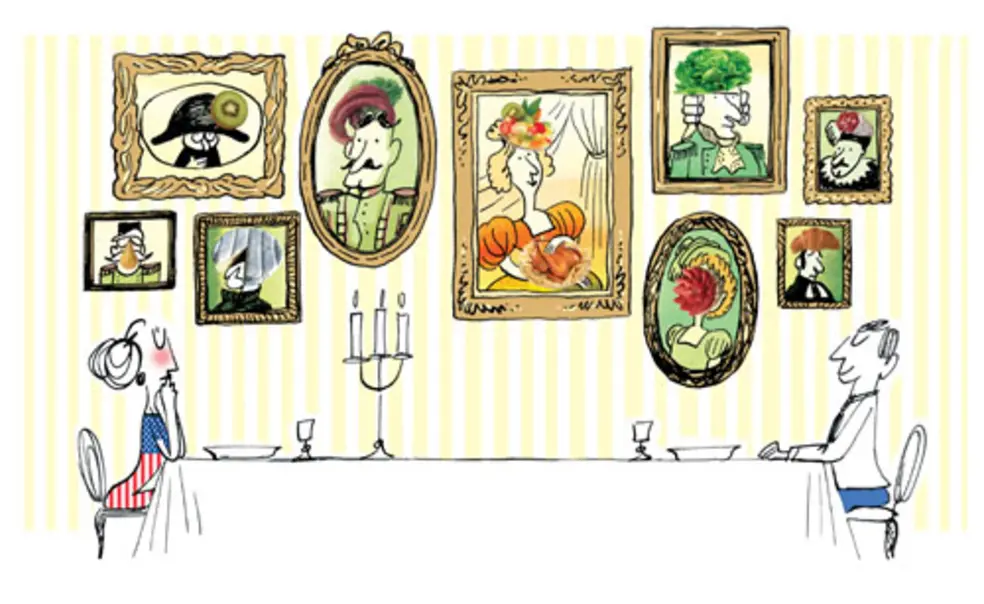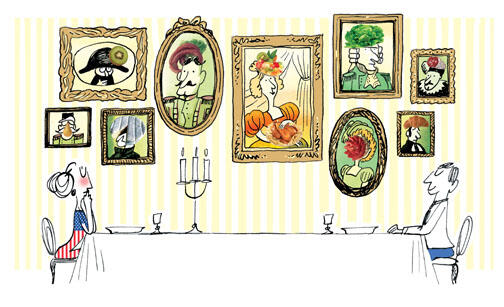Writer and television producer Renée Kaplan ’95 is the author, in French, of L’Amie américaine: Chroniques d’une New-Yorkaise à Paris.
Be careful how you talk about food with the French — especially if you’re American. That’s what I learned when I moved back to France a few years ago.
I remember my first Christmas Eve dinner with my then-new boyfriend’s family. It was a few months into our relationship, and Guillaume had seemed hesitant when inviting me, warning me that the holiday meal was très français. This annoyed me — did I somehow look like I couldn’t hack très français? I had grown up in France and spoke fluent French — I knew from Christmas bûche cake and foie gras.
Every dish had a story: from Guillaume’s mother’s recipe for the salmon terrine appetizer — a classified secret handed down from her own mother, so that all she could tell me was that if you didn’t make it with farm-fresh heavy cream bought from a creamery you trust, don’t bother; to the Saint Nectaire, a semifirm cheese from the Auvergne region that everyone agreed didn’t smell as much like damp earth in autumn as it should. It was important to my hosts that I understand the significance of this scent, so I inhaled deeply — I picked up a pretty heady fragrance of mildew and butter — and nodded with mouth full and eyebrows raised to show them I got it. By then, it was about 1 a.m., and I was encouraged to sample everything else on the heavily laden cheese platter, too, as everyone had a favorite regional specialty that was essential for me, as an American, to try. I was stuffed, drunk, and tired, but I played the compliant student.
Because if there is anything in which the French feel that, hands-down, they are superior to Americans, it’s food. The French love to hate American food. They think it’s unhealthy and fat-laden. They immediately associate it — and Americans — with fast food and industrialized food products, all of which the French heap into a godforsaken category they call malbouffe, which essentially means junk food, but with a glowering and moralizing tone. Food is heavily invested with a sense of national identity and pride and remains a vehicle of the great civilizing mission that many French still believe in. But the unrivaled supremacy of French cuisine has taken a few hits in recent years, with the rise of avant-garde Spanish cuisine, and the decline of the Michelin star-system. The French gastronomical ego is feeling tender. In short, the French don’t have much of a sense of humor about food these days.
I suspect that’s what Guillaume meant by warning me the Christmas Eve experience would be très français. I was not just a guest, I was a foreigner and, above all, to the family members I’d never met, I was a potentially savage and poorly fed American. So it was their role, indeed, their moral imperative, to educate me — not just because they are proud of their family traditions, but also because there is a greater cultural point to be made about French superiority. That might be related simply to questions of food, but there’s probably something else going on. There is a long history of rivalry between our two nations — or so the French think, not unlike the way Penn thinks about Princeton — and what better terrain on which to triumph than aged cheeses and caramel-apricot feuilleté? If you compare that to Munster and brownies, the competition’s not so tough.
I ronically, it turns out the French are some of their worst enemy’s best customers. France is McDonald’s second-largest market in the world, after the United States (though the company makes a point of stressing that it caters to French tastes and relies on local ingredients). That’s the real French paradox. And the French may look askance at American bellies and American burgers, but much of French food is veritably bursting with fat — after all, that’s why it tastes so good. In the part of Normandy that Guillaume’s mother comes from, a traditional appetizer is the tourte normande, a pie shell filled with bacon cubes, mushrooms, Livarot, Pont l’Evêque, Camembert, and crème fraîche — yes, that’s three different cheeses, pork fat, and heavy cream, and it’s served as a starter before the main dish.
Tourte normande is the French equivalent of junk food, I argued — it’s bad for your heart and bad for your butt, saturated with fat and cholesterol, and delivers the same primal satisfaction as a burger or a brownie. It’s not, Guillaume argued back, with a hint of contempt: It’s a regional dish rooted in generations of culinary practice, made with local and natural ingredients. It’s not a question of fat, he said; it’s a question of flavor. In brief, it’s not the same cholesterol if it’s cholesterol with tradition. I wanted to ask if that meant the body also took in the cholesterol with tradition differently — as if France has struck some special deal with lipids — but I realized this would be focusing on a tiny prosaic detail in the much bigger question that had nothing to do with LDL and HDL and everything to do with a nation’s sense of its place in the world. It all boils down to the French conviction that French fat is better than American fat.
Last fall, Guillaume and I spent a few days in California’s Marin County, foodie bastion of organic cuisine and regional ingredients. We ate locally made goat cheese and sourdough bread, we drank Napa Valley wines, and we met lots of Francophile Americans who gushed to Guillaume how much they loved France. He must have wondered who didn’t go on eating tours in Dordogne. I could see how tickled with pride he was, and how impressed he was with the food. “They have French tastes here!” he noted with genuine delight, as though the French owned the copyright on great cheese and wine. Bless his Gallic heart; it was the highest form of compliment.
The French may love to hate American food, and may take their culinary superiority for granted, but they still long for their food to be loved, especially by Americans. The recent book-turned-film Julie and Julia sparked an explosion of renewed interest in French cuisine in the United States. It was all over the French press that Julia Child’s famous cookbook, Mastering the Art of French Cooking, was selling out everywhere in American bookstores. Look, said the headlines, the Americans Find Us Irresistible, French Art of Living Still Seduces Them. Proof for the French that France remains enviable, that les Américains are still in thrall to us.
The irony is that les Américains always have been in thrall to French food. We’d all love to believe that we can cook and eat like the French — or, rather, like how we imagine the French cook and eat — and get away with it, with all the pastry and red meat that our current cardiovascularly hysterical culture forbids. Americans are obsessed with the original French Paradox, the idea that France is a place where you can have your cheese and eat it too. Although I couldn’t concede it in the heat of the argument, Guillaume is right when he says that it’s not the same cholesterol if it’s got tradition. What he means is there is something unique about the meaning the French invest in food, which makes their relationship to food — and to fat — different. A whole cottage industry in the United States has been built around attempts to define and capture that, generating dozens of books.
The reality is that the French do eat all that; they’re not afraid of a little slice of tourte normande or a chocolate fondant for dessert — sometimes. The French secret — are you ready? — is that fat is not bad. But they certainly don’t eat that every day at every meal. Just as in every other industrialized country, obesity rates in France are rising, but the French are still far less fat than les Américains. Americans hunt fat, avoiding it or consuming it guiltily, while it seems to us that the French do nothing more than indulge in it abundantly and then go on to die old and skinny. These days, they’re dying a little less skinny than they used to, but French food and French eating remain, literally, a fantasy for Americans. Really, what more could the French want?
très français













No responses yet